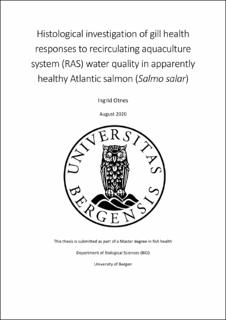Histological investigation of gill health responses to recirculating aquaculture system (RAS) water quality in apparently healthy Atlantic salmon (Salmo salar)
Master thesis
Permanent lenke
https://hdl.handle.net/11250/3119490Utgivelsesdato
2020-08-04Metadata
Vis full innførselSamlinger
- Master theses [269]
Sammendrag
Recirculating aquaculture system (RAS) technology has become more widespread in Atlantic salmon farming, and the need for knowledge about operating such a system has been highlighted in recent years. Gill pathology has been identified by fish health personnel as a bigger problem in RAS than in flow-through systems, and this thesis has sought to investigate potential factors influencing gill health in RAS. This was done by following a production cycle in three different RAS, where two were of commercial scale, and one was operated at a much lower stocking density. The difference in stocking density was included to illustrate potential differences in the organic loading of the systems. Total organic carbon and bacterial numbers were investigated on a biweekly basis, and regularly monitored water quality data was obtained from the systems. Apparently healthy fish were sampled, and throughout production an increase in clubbing, inflammatory cell infiltration in the clubbing, and inflammatory cell infiltration of the secondary lamellae showed a significant increase in all three systems. Bacterial numbers and TOC did not correlate, but the concentration of TOC in the system did increase in all three RAS. Potential interactions between TOC and the microbial community, as well as several microbial interactions which may affect gill health are discussed in this thesis.
